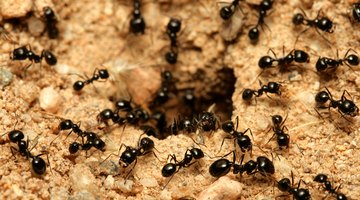Toddler Toenail Problems
Preventive measures can reduce your toddler’s risk of toenail problems. If your toddler regularly has toenail problems or has symptoms that are not disappearing regardless of your best effort, make an appointment with a podiatrist so relief can occur as soon as possible.
Causes
There are several causes of toenail problems that can affect your toddler. Bruising of the toenail can occur if the toenail is injured, such as from a toddler dropping something heavy on his foot. According to ePodiatry.com, trauma to the nail increases the risk of ingrown toenails. Ingrown toenails are common and occur when the nail grows into surrounding skin, sometimes actually penetrating the skin. In rare cases, your toddler may develop a toenail fungus infection; however, this most often occurs in older adults.
Identification

Baby Toenail Problems
Learn More
A bruised nail is easiest to identify because your toddler’s nail will appear black and blue, similar to a bruise anywhere on the body. Ingrown toenails often occur on the big toe. The pain associated with an ingrown toenail often begins as being mild, but as the nail begins growing farther into the skin, the pain cause a pulsing sensation that’s tender to have touched. The location where the nail is pressing into the skin may appear red, inflamed or have pus present. If your toddler has a toenail fungus, the nail may appear distorted and thick. The color will typically become darker as well and may have a yellow tint.
Treatment
Bruised nails can often go untreated; however, according to the Family Footcare Center, if pain is severe, the nail may need to be removed or drilled into to relieve pressure. A podiatrist can usually trim the corner of an ingrown toenail. If the toe is infected from an ingrown nail, an antibiotic will often be prescribed. In worst-case scenarios, part of the toenail will need surgically removed either permanently or temporarily. According to the Mayo Clinic, for a fungal infection, oral antifungal medication is more effective than topical. If the fungal infection is severe, surgery may be needed. Always wash your hands after touching your toddler’s fungal infection to reduce the risk of spreading the infection.
Prevention

Toenail Injury Due to Walking
Learn More
To avoid ingrown toenails, cut the nails straight across and avoid cutting them too short. Wearing tight shoes and socks increases your toddler's risk of ingrown nails, so be sure footwear is properly fitted. An open-toe shoe will keep the shoe from pressing the nail into the skin. In addition, some shoes have clear soles that allow you to visibly view your toddler’s foot as it grows, so you’re able to purchase a new size as soon as the shoe appears too small.
To avoid a fungal infection, keep the feet dry and clean. If your toddler will be at a public pool or shower, be sure he wears flip flops or swimming shoes. According to the Mayo Clinic, synthetic socks keep feet drier than cotton or wool socks. While indoors, take your toddler’s shoes off to reduce the entrapment of moisture around his feet. Bruises can be prevented by childproofing your house and keeping heavy objects out of your toddler’s reach.
Cutting
According to the American Academy of Pediatrics, your toddler’s toenails only need trimmed once a month because they grow slower than fingernails. It’s best to use a soft emery board to reduce the length of your toddler’s nails because filing reduces the risk of cutting the nails too short. If you prefer toenail clippers, cut the nails while your toddler is sleeping so he will not move during the procedure. Always use an emery board to smooth sharp edges, which will reduce the chance of the nail's penetrating the skin.











